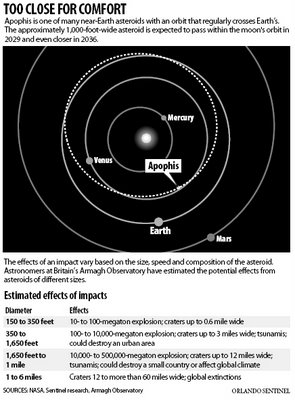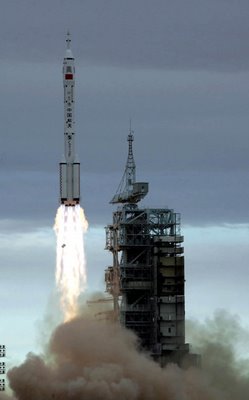Bevin Chu
May 19, 2006
Neoconservative China Threat theorists responsible for America's strategic policy are determined to cast a non-aggressive, free market oriented China as a "New Evil Empire," and the long-suffering Chinese people as 21st century counterparts of Genghis Khan's Mongol hordes. Their "China Threat" is an imaginary, rather than real threat. Other threats meanwhile, such as space rock hitting the earth, are real rather than imaginary threats.
Space rock could hit Earth in April 2036, say expertsKnight Ridder 2006-05-16
By Michael Cabbage
Mark your calendar for Sunday, April 13, 2036. That's when a 1,000-foot-wide asteroid named Apophis could hit the Earth with enough force to obliterate a small state. The odds of a collision are 1-in-6,250. But while that's a long shot at the racetrack, the stakes are too high for astronomers to ignore. For now, Apophis represents the most imminent threat from the worst type of natural disaster known, one reason NASA is spending millions to detect the threat from this and other asteroids. A direct hit on an urban area could unleash more destruction than Hurricane Katrina, the 2004 Asian tsunami and the 1906 San Francisco earthquake combined. The blast would equal 880 million tons of TNT or 65,000 times the power of the atomic bomb dropped on Hiroshima. Objects this size are thought to hit Earth about once every 1,000 years, and, according to recent estimates, the risk of dying from a renegade space rock is comparable to the hazards posed by tornadoes and snakebites. Those kind of statistics have moved the once-far-fetched topic of killer asteroids from Hollywood movie sets to the halls of Congress. "Certainly we had a major credibility problem at the beginning, a giggle factor," said David Morrison, an astrobiologist at NASA's Ames Research Center in California. "Now, many people are aware this is something we can actually deal with, mitigate and defend against."
Deflecting threats
In 1998, lawmakers formally directed NASA to identify by 2008 at least 90 percent of the asteroids more than a kilometer wide that orbit the sun and periodically cross Earth's path. That search is now more than three-quarters complete. Last year, Congress directed the space agency to come up with options for deflecting potential threats. Ideas seriously discussed include lasers on the moon, futuristic "gravity tractors," spacecraft that ram incoming objects and Hollywood's old standby, nuclear weapons. To help explore possible alternatives, former Apollo astronaut Rusty Schweickart has formed the B612 Foundation. The organization's goal is to be able to significantly alter the orbit of an asteroid in a controlled manner by 2015. "You can watch all of the golf on television you want, but if you want to go out and break par, it's going to take a lot of playing," Schweickart said. "And you're going to learn a lot that you thought you knew, but you didn't."
Throughout their 4.5 billion-year history, Earth and its neighboring planets have been like sitting ducks in a cosmic shooting gallery. A glance at our moon shows the scars left by countless collisions with asteroids and comets. In fact, the moon is thought to have been created when part of the early Earth was ripped away in a cosmic impact with an object the size of Mars. Earth also has scars, but most have been hidden by vegetation or eroded by geologic processes such as rain and wind. About 170 major impact sites, including northern Arizona's 4,000-foot-wide Barringer Crater, have been identified around the globe.
Alvarezes' research
Within the past century, an extraterrestrial chunk of rock about 200 feet wide is thought to have caused a 1908 blast near Tunguska, Siberia, that leveled 60 million trees in an area the size of Rhode Island. Researchers theorize the object exploded four to six miles above the ground with the force of 10 million to 15 million tons of TNT. Few outside scientific circles took the threat posed by near-Earth objects seriously until 1980. Then, Luis and Walter Alvarez published a study based on geologic evidence that concluded a cataclysmic asteroid or comet impact 65 million years ago caused the mass extinction of two-thirds of all plant and animal life on Earth, including the dinosaurs. Dubbed the Great Exterminator, the colossal object was estimated at 7 miles in diameter and created a blast hundreds of millions of times more destructive than a nuclear weapon.
Objects that size are thought to hit Earth about every 100 million years. NASA scientists studying satellite photos bolstered the Alvarezes' theory with the discovery in 1991 of an impact crater 125 miles wide buried beneath the northwestern corner of Mexico's Yucatan Peninsula. Three years later, NASA photos of another sort drove home the potential for cosmic collisions in our part of the solar system. Spectacular images from the Hubble Space Telescope of Comet Shoemaker-Levy's collision with Jupiter showed 21 comet fragments, producing colossal fireballs that rose above the giant planet's cloud deck. "I think the most important development for getting this (public awareness) going was the Alvarezes' research that the dinosaurs went extinct as the result of an impact," Morrison said. "We were faced with a real example where an impact had done terrible damage."
In 2029, the asteroid will come closer to our planet than the television and weather satellites that beam back signals from 22,300 miles above. Astronomers' big fear is that Apophis will pass through a gravitational "keyhole" that will put it on a collision course with Earth in 2036. "For all practical purposes, it (a mission) would have to be done before the 2029 flyby to take advantage of the leverage afforded by that encounter," said Steve Chesley, an astronomer in the Near Earth Object Program. "That means the 2036 impact needs to be addressed by 2026."
Orbit of Near Earth Asteroid Apophis Comment:
Neoconservative China Threat theorists responsible for America's strategic policy are determined to cast China as a "New Evil Empire," and the Chinese people as Genghis Khan's Mongol hordes. Any sign that the Chinese people are making economic, but particularly scientific and technological progress, is cited as alarming evidence of Barbarians at the Gates and Apocalypse Now.
The Fiendish Plot of Dr. Fu Manchu
The China Threat theorists' anxieties are not reflections of any real world Fiendish Plot of Dr. Fu Manchu against the "democratic west." The China Threat theorists' anxieties are psychological projections of the Malevolent Global Hegemonists' disowned shadow onto a convenient external screen. As Wikipedia explains, Psychological projection (or projection bias) can be defined as unconsciously assuming that others have the same or similar thoughts, beliefs, values, or positions on any given subject as oneself. According to the theories of Sigmund Freud, it is a psychological defense mechanism whereby one "projects" one's own undesirable thoughts, motivations, desires, feelings—basically parts of oneself—onto someone else (usually another person, but psychological projection onto animals, inanimate objects - even religious constructs - also occurs). The principle of projection is well-established in psychology. Peter Gay describes it as "the operation of expelling feelings or wishes the individual finds wholly unacceptable—too shameful, too obscene, too dangerous—by attributing them to another."
I touched on this phenomenon in my 1999 essay, Hollywood's Tibet, in which I pointed out how Hollywood celebrities desperate to be perceived as Politically Correct have projected America's collective guilt over its treatment of American Indians onto China. Psychological projection however, is hardly confined to the Beautiful People in Hollywood. It is if anything, even more commonplace among the Political Class in Washington. China Threat Theory at its root, is the Benevolent Global Hegemonists' projection of their own malevolent desire for global hegemony onto a strange and exotic people. You know, those mysterious heathens with yellow skin and slanted eyes, always scurrying about, speaking in strange tongues, plotting who knows what against white European civilization.
China Threat Theory, when one stops to think about it calmly and objectively, has no basis in reality. Even Australia, which is far closer to China than the US, and strategically far more vulnerable, considers the China Threat Theory sheer poppycock. Objectively speaking, what is there to fear about China's recent progress? Objectively speaking, nothing whatsoever. China's progress is an integral part of mankind's progress. China's progress doesn't benefit only the Chinese people. China's progress, like America's progress, like Europe's progress, like Russia's progress, like India's progress, benefits mankind as a whole. That progress includes China's astonishingly rapid advances in aerospace technology.
China launches Shenzhou 6
In the science fiction thriller Armageddon (1998, directed by Michael Bay, written by Robert Roy Pool, Jonathan Hensleigh, starring Bruce Willis, Ben Affleck, Liv Tyler) an asteroid the size of Texas threatens to destroy the planet earth. Only the combined resources of US and Russian space technology succeed in saving all life on earth, including the human race, from extinction.
Armageddon
Armageddon was a terrible movie, but according to respected scientists the movie's premise, that life on earth might one day be extinguished by a stray asteroid, is entirely likely. According to reputable astronomers the asteroid Apophis may well pose a threat to earth in 2036, a mere 30 years from now. Suppose for the sake of argument that the China Threat theorists have their way. Suppose they succeed in using Taiwan independence as a pretext to launch a "preventive" war of aggression against a peacefully developing China. Suppose they "win" such a war. Suppose they succeed in their quest to "contain China" and set China's development back 30, 40, even 50 years.
What then? What will Neoconservative China Threat theorists do when another Great Exterminator hurtles toward earth, and they realize too late that crucial Chinese space technology, complementing US and Russian space technology, might have been able to intercept an asteroid or comet and ensure the survival of the human race, including 290 million Americans? Anyone who snorts at such a suggestion, on the contemptuous assumption that "China doesn't rate," has either forgotten China's countless contributions to world civilization, or was woefully ignorant of them in the first place.
As Professor Robert Temple, a British historian and archeologist notes: People often speak of the modern world in which we live, and presume that it is a creation of the Western world. But this is not correct. More than half of the basic inventions and discoveries which led to the creation of this modern world are Chinese, and are not Western at all. Indeed, China has produced more fundamental inventions and discoveries than the rest of the world put together. Because so few people realize this, the view of China's place in the modern world is wrongly conceived.
Most people in both East and West believe that China is emerging into the modern world. But China is not emerging into anything, it is re-emerging into something which it helped to create in the first place. Nor is China a developing country: it is a re-developing country. For two thousand years, China was developed while most of the rest of the world was undeveloped. It was richer, it was stronger, it was bigger, it could feed itself better, it could build more things of greater magnitude, and it could explore when it wanted to.
See: http://thechinadesk.blogspot.com/2002/01/modern-world-joint-creation-of-china.html
The US government is squandering astronomical sums that American taxpayers can ill afford, to wage a nominally defensive, but in fact offensive war of aggression against China. In doing so, it is forcing the PRC government to respond by diverting sums mainland Chinese taxpayers can ill afford, into defending China's territorial integrity from the American Empire. The so-called China Threat is an imaginary rather than real threat. A killer asteroid, once thought of as nothing but grist for the science fiction movie mill, is a real rather than imaginary threat. Instead of pretending that it is defending America against a non-existent China threat, the US government should facilitate private sector cooperation between American and Chinese scientists and engineers to defend America, China, and the rest of the world from a scientifically verifiable threat of annihilation from outer space.




Unfortunately this website has come to the attention of spammers. Therefore I have been forced to resort to word verification.
ReplyDeleteBevin Chu
Nice post thank you Nicholas
ReplyDelete